Outdoor Essentials for Relaxation and Entertainment 1. Keter Outdoor Side Table with 7.5-Gallon Cooler Best For: Backyard parties, tailgating, poolside relaxation Key Features: • Functions as a side table, cooler, and storage unit • 7.5-gallon insulated interior keeps drinks cold • Stylish rattan-like design fits any outdoor setting • Weather-resistant and durable construction Why It’s Essential: Forget running back and forth for drinks—the Keter Outdoor Side Table Cooler keeps beverages within arm’s reach while doubling as a chic patio table. Ideal for summer barbecues, poolside lounging, or an upgraded glamping setup.
- Jearey 9-Foot Outdoor Patio Umbrella Best For: Sun protection, backyard lounging, patio setups Key Features: • UV-resistant canopy for optimal shade • Sturdy aluminum pole with crank lift system • Ventilated design prevents wind damage • Available in multiple colors to match any style • Available in different sizes – 9ft to 12ft Why It’s Essential: A great outdoor space isn’t complete without the right shade. The Jearey Patio Umbrella provides relief from the sun while adding a stylish touch to your patio or backyard.
- GoSports Classic Cornhole Set Best For: Backyard parties, tailgating, family gatherings Key Features: • Tournament-size cornhole boards with vibrant designs • Weather-resistant bean bags for durability • Foldable legs for easy transport and storage • Fun for all ages and skill levels • 2 sizes – 3x2 or 4x2 Why It’s Essential: Nothing brings people together like a good game of cornhole. Whether it’s a backyard barbecue or a casual glamping trip, the GoSports Cornhole Set guarantees entertainment for everyone.
Nomad & Mad Lynn’s Ultimate Backyard Challenge Nomad stretched out under their new Jearey Patio Umbrella, sipping a cold drink from the Keter Cooler Table while watching Mad Lynn take her turn at cornhole. “You’re gonna lose,” he taunted. Mad Lynn narrowed her eyes. “Oh, it’s on.” The sun was setting, and their backyard had become an outdoor haven—cool drinks, comfortable shade, and a fierce cornhole rivalry. Decision Time! • Option A: Nomad bets his next turn on a trick shot—a risky but legendary move. (Turn to Section A) • Option B: Mad Lynn focuses, aiming for a perfect game-winning shot. (Turn to Section B)
Section A: The Trick Shot Gamble Nomad balanced a bean bag on his foot, flicked it into the air, and smacked it mid-flight toward the board. It sailed… It curved… It missed! Mad Lynn howled with laughter. “Should’ve stuck to the basics, hotshot.” Moral of the Story: Sometimes, flashy moves don’t pay off—play smart!
Section B: The Focused Approach Mad Lynn took a deep breath, aimed carefully, and released the bean bag with precision. It landed perfectly on the board, sliding into the hole. Game. Over. Nomad sighed, handing over his drink. “Fine, you win.” Mad Lynn grinned. “Again?” Moral of the Story: Focus and patience win the game.
Final Verdict: Prepper vs. Preppy • Prepper View: A sturdy table, reliable shade, and quality outdoor games make any off-grid, campsite or backyard setup more enjoyable and practical. • Preppy View: These accessories elevate the outdoor experience, combining function with style and relaxation. Get your Game On!
Upgrade Your Outdoor Space Now! Keter Outdoor Side Table Cooler – Buy Now Jearey Patio Umbrella – Buy Now GoSports Cornhole Set – Buy Now Whether you’re hosting friends, relaxing solo, or engaging in fierce backyard competitions, these must-have products take your outdoor experience to the next level!
End Article BR 3/2025
Upgrade Your Outdoor Space Now!
Keter Outdoor Side Table
GoSports Cornhole Set
Whether you’re hosting friends, relaxing solo, or engaging in fierce backyard competitions, these must-have products take your outdoor experience to the next level!
Nothing Better than Pancakes for Breakfast When Camping!

There’s something special about pancakes. They’re simple, they’re versatile, and they always taste delicious. But there’s one place where pancakes really shine: camping!
Camping is a great way to enjoy nature and get away from the hustle and bustle of everyday life. And what could be better than starting your day with a hot, freshly made pancake breakfast? Not much, that’s for sure!
There’s something about pancakes that just make them perfect for camping. Maybe it’s the fact that they’re easy to make, or maybe it’s because they always taste so good. Whatever the reason, we think pancakes are the perfect breakfast food for any camping trip.
So, if you’re looking for a delicious and easy breakfast option for your next Fall camping trip, look no further than these four pancake recipes! Trust us, you won’t be disappointed. This is an easy recipe to teach your kids how to make!
 Timeframes to complete this recipe have everything to do with making sure you have all your tools and ingredients first and at the ready. These are estimated timeframes:
Prepper: 30 minutes
Preppy: 45 minutes
Skill Level: 1 out of 5 (some mixing & flipping)
Tools Required
• Rubber spatula
• Wire Whisk
• Mixing Bowl
• Flat Iron
Timeframes to complete this recipe have everything to do with making sure you have all your tools and ingredients first and at the ready. These are estimated timeframes:
Prepper: 30 minutes
Preppy: 45 minutes
Skill Level: 1 out of 5 (some mixing & flipping)
Tools Required
• Rubber spatula
• Wire Whisk
• Mixing Bowl
• Flat Iron
Pumpkin Spice Pancakes If you love pumpkin spice, then you will absolutely love these pumpkin spice pancakes. The pumpkin flavor is very pronounced and pairs perfectly with the spices. These pancakes are also very moist and fluffy, so they are sure to be a hit with everyone. Serve them with a dollop of whipped cream and a sprinkle of cinnamon for a truly delicious treat. Ingredients: • 1 cup all-purpose flour • 2 tablespoons sugar • 1 teaspoon baking powder • 1/2 teaspoon baking soda • 1/2 teaspoon salt • 1 teaspoon cinnamon • 1/4 teaspoon nutmeg • 1/4 teaspoon ginger • 1 cup milk • 1/2 cup pumpkin puree • 2 tablespoons vegetable oil or melted butter • 1 egg Instructions: 1. In a large bowl, whisk together the flour, sugar, baking powder, baking soda, salt, cinnamon, nutmeg and ginger. 2. In a separate bowl or measuring jug, whisk together the milk, pumpkin puree, oil or butter, and egg. 3. Add the wet ingredients to the dry ingredients and mix until just combined. 4. Heat a griddle or frying pan over medium heat and grease with oil or butter. 5. Scoop 1/4 cup batter onto the griddle for each pancake. Cook for 2-3 minutes per side, or until golden brown. 6. Serve with butter and maple syrup. Enjoy!
End Recipe GR12/2024 Article Source: https://happycampingmama.com/the-best-of-fall-4-delicious-pancake-recipes-to-make-on-your-next-camping-trip
Bugout Backpack for 3 People – 72-Hour Emergency Survival Kit

Bugout Backpack for 3 People – 72-Hour Emergency Survival Kit
Disclosure: This post contains affiliate links. If you click through and make a purchase, I may earn a small commission at no additional cost to you. As an Amazon Associate, I earn from qualifying purchases.
Overview
In times of unexpected emergencies, having a well-prepared survival kit is crucial. The Bugout Backpack for 3 People – 72-Hour Emergency Survival Kit is designed to support a family of three for up to 72 hours, providing essential supplies to help you navigate through disasters with confidence.
Key Features and Benefits
Comprehensive Supplies
• Food and Water: Includes high-calorie food packages and water supplies with a 5-year shelf life, ensuring sustenance during critical times.
• First Aid Kit: Equipped with a comprehensive first aid kit to address minor injuries and medical needs.
• Shelter and Warmth: Contains emergency blankets and ponchos to protect against harsh weather conditions.
Durable and Portable Design
• Sturdy Backpack: The heavy-duty backpack is designed for durability and easy portability, allowing you to carry essential supplies comfortably.
• Organized Storage: Multiple compartments help keep items organized and easily accessible during emergencies.
Additional Tools
• Multifunctional Tools: Includes essential tools such as a flashlight, whistle, and multitool to assist in various situations.
• Hygiene Supplies: Provides basic hygiene items to maintain cleanliness during prolonged use.
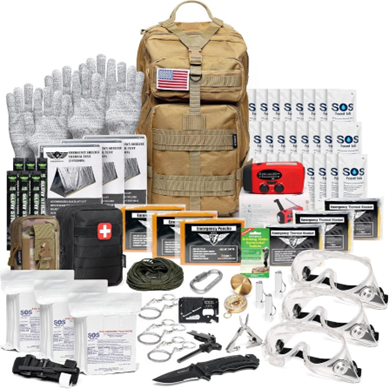
Why Choose This Bugout Backpack?
This survival kit is tailored for families of 3, ensuring that each member has access to necessary supplies during emergencies. Its comprehensive nature and thoughtful organization make it a reliable choice for disaster preparedness.
Be prepared for the unexpected. Equip your family with the Bugout Backpack for 3 People – 72-Hour Emergency Survival Kit and ensure peace of mind during uncertain times. Images used in this post are sourced from the Amazon Product Advertising API or Amazon product pages.
End Article BR12/2024
Bugout Backpack for 3 People – 72-Hour Emergency Survival Kit
ORRNIKKO Heated Vest for Women

ORRNIKKO Heated Vest for Women
Disclosure: This post contains affiliate links. If you click through and make a purchase, I may earn a small commission at no additional cost to you. As an Amazon Associate, I earn from qualifying purchases.
Winter weather doesn’t stand a chance with the ORRNIKKO [2024 All-New] Heated Vest for Women. Imagine stepping into the cold and feeling a cocoon of warmth enveloping you—this vest delivers just that. Whether you’re on a brisk morning hike, shoveling snow, or cheering at a frosty outdoor event, this vest ensures you’re both warm and stylish.
Why You’ll Love It Customizable Warmth: The standout feature here is the detachable heated hood. On especially windy days, the hood adds an extra layer of protection. Don’t need it? No problem—just remove it. Plus, the separate heating controls for the hood and vest allow you to tailor the warmth exactly where you need it. Safety First: Let’s talk about that battery—this vest comes with a UL-certified 7.4V 16,000mAh power pack. Not only does it keep you warm for hours, but it also doubles as a phone charger. And if things get too toasty, the battery has an automatic shutoff feature above 150℉, keeping you safe without sacrificing comfort. Cozy Yet Eco-Conscious: The fabric is a game-changer. Soft, breathable, and made with eco-friendly GRS-certified materials, it feels luxurious without being heavy. Add the water-resistant coating, and you’re ready for any unexpected snow or drizzle. Full-Body Warmth: With eight heating zones, this vest doesn’t leave you wishing for more. Your core stays toasty with heating panels in the chest, back, and even the pockets (perfect for warming up your hands). Adjust the temperature with four simple settings to match the day’s chill.

Perfect for Any Occasion Here’s what you get: • A stylish vest in a sleek carrying bag, great for storage or gifting. • A detachable hood for added versatility. • A laundry bag to make washing easy and worry-free. • The game-changing battery pack with a charging cable.
Size Tips Before you order, take a minute to check the size chart—it’s the best way to ensure a perfect fit. If you’re unsure, the size label inside the collar makes exchanges straightforward.
Final Thoughts The ORRNIKKO Heated Vest is more than just a vest; it’s an essential winter companion. It’s practical, stylish, and designed with the modern woman in mind. Whether you’re running errands or adventuring outdoors, this vest ensures you’re warm, comfortable, and ready to take on the day.
Ready to embrace the warmth? Click here to grab yours today. (Stock photo included above to showcase the sleek design and functionality.)
This post contains affiliate links. If you click through and make a purchase, I may earn a small commission at no additional cost to you. As an Amazon Associate, I earn from qualifying purchases.
End Article BR12/2024
Ready to embrace the warmth? Click here to grab yours today.
Camping Shovel Axe Outdoor Survival Shovel Set
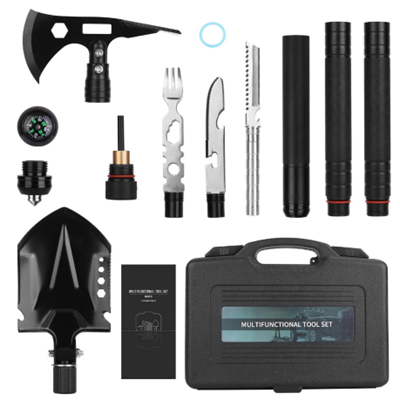
Camping Shovel Axe Outdoor Survival Shovel Set
Disclosure: This post contains affiliate links. If you click through and make a purchase, I may earn a small commission at no additional cost to you. As an Amazon Associate, I earn from qualifying purchases.
Camping Shovel Axe Outdoor Survival Shovel Set For outdoor enthusiasts and survivalists, the Camping Shovel Axe Outdoor Survival Shovel Set is a versatile and essential tool. This multifunctional set combines durability with practicality, making it a reliable companion for various outdoor activities.
Key Features and Benefits Multifunctional Design • All-in-One Tool: This set includes a shovel, axe, saw, and other survival tools, providing versatility for tasks like digging, chopping, and cutting. • Compact and Portable: Designed to be collapsible, it easily fits into the included carrying case, making it convenient to transport and store. Durable Construction • High-Quality Materials: Made with high carbon steel, the tools are built to withstand rigorous use in various environments. • Ergonomic Handle: The handle is designed for a comfortable grip, reducing hand fatigue during extended use. Adjustable Length • Customizable Size: The extension bars allow you to adjust the tool’s length to suit different tasks, enhancing its functionality.
What’s Included • Camping Shovel Axe Set: A comprehensive set of tools for various outdoor needs. • Carrying Case: A durable case for easy storage and transportation.

Why Choose This Survival Shovel Set? Whether you’re camping, hiking, or preparing for emergencies, this survival shovel set offers the versatility and durability needed to handle a range of tasks. Its compact design ensures it doesn’t take up much space, making it an ideal addition to your outdoor gear.
Ready to enhance your outdoor adventures? Check out the Camping Shovel Axe Outdoor Survival Shovel Set and equip yourself with a reliable multifunctional tool. Images used in this post are sourced from the Amazon Product Advertising API or Amazon product pages. End article BR12/2024
Camping Shovel Axe Outdoor Survival Shovel Set
How to make Survival Stew

How to make Survival Stew
Timeframes to complete this recipe have everything to do with making sure you have all your tools and materials first and at the ready. These are estimated timeframes: Prepper: 1 to 2 hours Preppy: 2 hours Skill Level: 1 out of 5 (some can opening, stirring)
The forest breathed a faint sigh as the last light of day slipped below the horizon. The gray-blue sky hung heavy with the chill of late fall, promising a cold night ahead. Joshua tugged his scarf tighter against his neck, the fabric rough but welcome as it shielded him from the biting air. He dropped his pack to the ground with a dull thud, surveying the clearing he’d chosen for the night. The small patch of earth was tucked near a gentle stream, flanked by tall oaks whose skeletal branches reached toward the fading light.
“This’ll work,” he murmured, his breath fogging in the air. The fire would need to happen first. The night wasn’t going to wait for him, and warmth had to come before anything else.
He knelt to clear the ground, scooping away layers of damp leaves until bare earth appeared. His hands moved deftly, arranging kindling into a neat pyramid before striking a match. The bark caught quickly, and soon the small flames danced hungrily, licking at the larger sticks he added to the pile. The fire crackled, its glow cutting through the encroaching shadows.
With the fire alive, Joshua pulled out his cooking gear—a well-worn aluminum pot and a vacuum-sealed bag labeled Survival Stew Mix. The bag crinkled in his hands as he opened it, revealing a mix of lentils, rice, dehydrated vegetables, and a bouillon cube. He filled the pot with water from the stream, filtering it carefully before setting it over the fire.
The stew mix hit the water with a soft hiss, and Joshua stirred it with the back of his spoon, watching as the lentils sank to the bottom and the vegetables floated on the surface. The faint aroma of garlic and herbs rose with the steam, and for a moment, the cold seemed a little less sharp.
While the stew simmered, he turned to the rest of his camp. Pulling his tent from his pack, he worked quickly, threading the poles and snapping them into place. The fabric glinted softly in the firelight, a deep green that blended with the forest floor. He pitched it just far enough from the fire to avoid sparks but close enough to catch some of its warmth. Inside, he unrolled his sleeping bag, giving it a quick fluff before smoothing it over a foam mat. The setup was small, simple, but exactly what he needed.
Joshua stepped back out into the clearing, pausing to gather an armful of firewood from the surrounding forest. The night would be long, and the fire couldn’t be allowed to die. He stacked the wood neatly near the flames, sorting the branches by size and adding a few to the fire to keep it steady.
The stew was bubbling now, its aroma rich and comforting, filling the crisp air with the promise of something warm and satisfying. Joshua crouched by the fire, giving the pot a gentle stir. The lentils had softened, the rice was plump, and the dehydrated vegetables had rehydrated into bursts of color. He tasted it, nodding in approval. It was hearty, savory, and exactly what he needed after a day of hiking.
Ladling the stew into his tin bowl, he settled onto a flat rock near the fire. The heat of the bowl seeped into his hands as he ate slowly, savoring every bite. The warmth spread through his chest, easing the tension in his shoulders and making the cold seem less oppressive. Above him, the stars pricked through the night sky, bright and unbothered by the chill.
When he was finished, Joshua rinsed the pot in the stream, his hands trembling slightly from the icy water. Back at the fire, he added more logs, watching as the flames leapt higher, casting flickering shadows against the surrounding trees. Crawling into the tent, he zipped it closed behind him and slid into his sleeping bag. The fire outside crackled steadily, a comforting barrier between him and the wild night.
As he closed his eyes, he felt a deep sense of contentment. The forest could do its worst, but he was ready. Joshua drifted off, the scent of woodsmoke and stew still lingering in the air, his body cocooned in the sleeping bag and his mind at peace with the wilderness.
How To Make Survival Stew - nutrient-dense, long-lasting, and easy to prepare with minimal resources.
Survival Stew Recipe
Ingredients:
• 1 cup dried lentils
• 1 cup rice (white or brown)
• 1 cup dehydrated vegetables (carrots, celery, onions, etc.)
• 2 bouillon cubes (chicken or vegetable)
• 1 teaspoon garlic powder
• 1 teaspoon onion powder
• ½ teaspoon dried thyme
• Optional: Salt, pepper, or a drizzle of oil for added flavor
Tools: 1 – 4-quart Stew pot (preferably cast iron) 1 – Long wooden spoon for stirring 2 – Bowls to enjoy with a friend Directions:
Bring 4 cups of water to a boil over a fire or stove.
Add all ingredients to the pot, stirring gently.
Simmer for 15–20 minutes, stirring occasionally, until the lentils and rice are tender.
Serve hot and enjoy the warmth it brings to a cold night.
End recipe BR12/2024
A Beginner’s Guide to Clearing Land
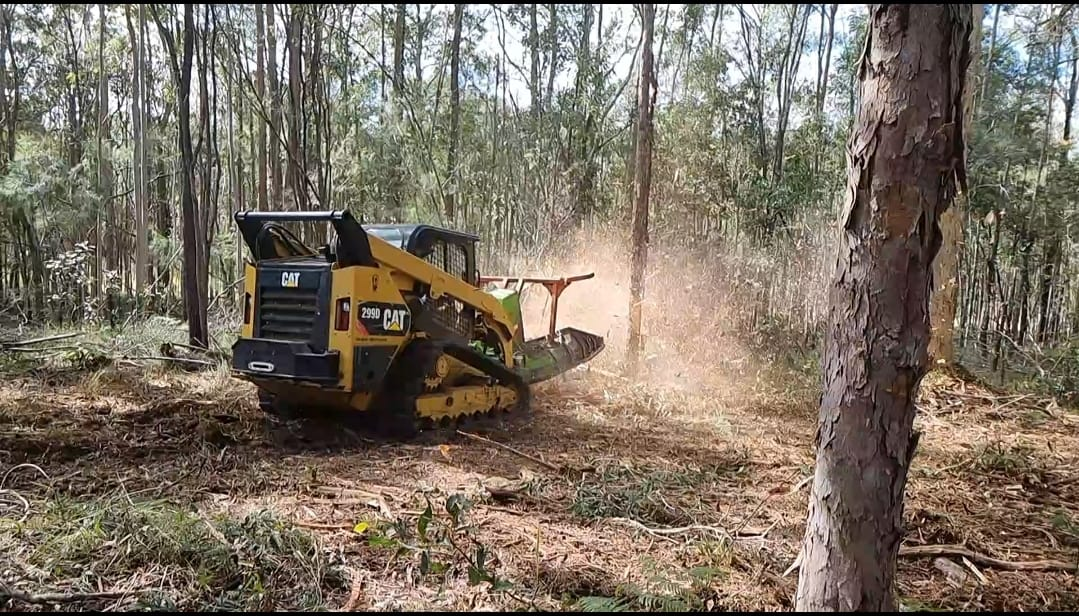
A Beginner’s Guide to Clearing Land Timeframes to complete this project have everything to do with making sure you have all your tools and materials first and at the ready. These are estimated timeframes: Prepper: Weeks to Months Preppy: Many Months to Years Skill Level: 4 out of 5 (some shovel digging & rock hauling; Heavy equipment operation, drainage/run-off design, Hauling debris, harvesting trees, Fencing, Animal care, Permitting, Knowing where to dig. Need to eat lots of Wheaties every morning to get the muscle power you will need.) WARNING: Clearing land is not for the faint of heart or the lazy. It requires much work and if it isn’t done right, you can permanently damage the landscape, and incur extensive penalties from your county or state, or EPA.
Step 1: Assess the Land You never want to just grab tools and start without first evaluating the area. There are many factors that influence the approach you should take to clearing land. Some questions to ask yourself include: • What do I want to do with this land? • Are there any pieces of vegetation, such as trees, that I want to keep? • How big are the trees and shrubs? Do they any have deep roots? Will I need to remove the stumps? • Are there any structures on the property? • What is the quality of the soil? Do I need to remove rocks? Once you have a strong idea of what should be removed, determine what tools you need to carry out this project. If you are unsure about what equipment will be necessary for a specific growth or structure, seek advice from a trusted friend or neighbor. Sometimes a worker at a home improvement store can also help you identify which tools are required to clear the land. Step 2: Create a Budget and a Plan Once you have a strong assessment of the land, you will then need to establish a budget for the project. This will help in making a plan to clear the land. Some tasks will require larger, more expensive tools. If you need to remove difficult objects such as a stump or structure, you may also need to rent a bulldozer. Be sure there is room in your budget for the rental of any equipment, if necessary. For larger trees, you will likely need to request a quote from a tree removal service. It is always a good idea to compare quotes from several companies before making a final decision. With an established budget and understanding of the cost of your project, you can then move forward with creating a plan for how long it will take and the order in which you will complete the tasks. Before you do any work on your property that might involve digging, make sure to call Ms. Utility for your area to have them mark where it’s safe to dig. Usually dialing 811 will get you to the correct people. In NY you can also check here: https://udigny.org/ Here is a general outline to follow when clearing land: 1. Remove structures such as buildings, sheds, chicken coops, barns, or fences if possible 2. Cut down unnecessary trees 3. Clear large rocks 4. Dig up tree stumps 5. Clear any brush or weeds 6. Level the land 7. Plow the soil Not every step will be necessary for all land clearing projects. The outline is to assist you in developing your individualized strategy. Step 3: Check for Any Necessary Permits To ensure no permits are necessary for your land clearing project, you will need to contact your local government. This step is especially important for larger projects. There may be regulations on how to remove trees or dispose of timber. Your property may also include gas, sewer, or water lines that need to be identified and avoided. In addition, land clearing can sometimes become an environmental issue, so you will want to get your project approved before you get started. Step 4: Clear the Land This is the step where you finally get to see results. Be sure to follow all safety measures when working with tools. Wear gloves and goggles, if necessary. If you are using power tools, it can be beneficial to wear ear plugs to prevent hearing loss. Clearing land can be hard work, so remember to take frequent breaks and drink plenty of water.
Step 5: Clean Up and Dispose of Waste After all of the uprooting and cutting is done, you will need to remove the pulled weeds, timber, or structural fragments from the land. The weeds can be placed in the yard waste bin to be taken out with the trash. If the remaining timber can be utilized, you can either sell it or store it for a future project. The structural fragments will need to be disposed of properly. Save any materials that can be reused. Any other parts can typically be thrown away in a large dumpster. We often burn the wood leftover from clearing areas of our property, but make sure NOT to burn any poison ivy or other poisonous plants; this can cause health issues for anyone who breathes in the smoke. Consider renting a woodchipper if you can use wood chips on your property for gardening or mud control. Step 6: Prepare Your Land for Use After the land has been cleared, the last step is to prepare the property for its designated purpose. You may need to plant grass seed or lay down sod. For any type of farmland or yard, a fence could also be necessary. If you are looking for advice on installing a fence, here are helpful articles to get you started: • Types of Wire Fencing • Electric Fence Installation for a Family Farm • How to Dig a Fence Post Hole by Hand Best Season to Clear Land The best season to clear land is NOT when things are in full bloom. In our area, early Fall and early Spring are a great time to clear the land because the plants aren’t growing or growing as quickly. It gives you time to get things cleared without competing with new growth. If you start in the Fall, you can clear things out, plant grass seed, and you’ll have some time before new growth will start competing. The downfall is that Fall rain or snowfall may increase mud. Winter is a fantastic time to work because there’s no growth at all to compete with. The ground may, however, be frozen, and it’s not always my favorite weather to work out in. The main issue I have with working in the winter, however, is that it’s nice to work during a time of the year where you can identify poison ivy and other poisonous plants. Once winter comes and the leaves fall off, it’s sometimes hard to identify these plants. Unfortunately, you can still get poison ivy in the winter as the whole plant produces the oils. Here’s some photos of the areas we are trying to clear in the late winter. As you can see, my husband was out here with his chainsaw cutting some older trees down/apart. We’ve been hauling them to our woodshed slowly.


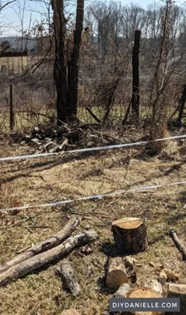
Best Equipment to Clear Land Whatever method you use to clear land, it’s important to remember that the brush and trees will grow back if you take too long. It’s better to clear a small portion of land, seed it with the appropriate grass, then move on to the next portion if it will be a slow process. To give an example, we’re letting our goats and sheep clear brush in our back pasture. Ideally, we would use temporary fencing to contain them in a small area, 1/4 acre or thereabouts, wait until the area is mostly clear, then rotate them to a new area. The goat manure is a good fertilizer and we could seed grass in the cleared zone; we would need to clear anything by hand that they didn’t take care of first, however. If you want to clear the land in a shorter period of time, you either need a huge team to help clear by hand, or you need the proper equipment. You can rent equipment or hire a company to come and clear the land for you. Here are your options for equipment and tools to clear land: • Disc mulcher • Root plow • Land excavator • Bobcat Clearing Land the Old Fashioned Way We have been clearing land “by hand.” We’ve used a variety of hand tools, including: • Chainsaw: Stihl is a highly recommended brand. You want a fairly high-powered chain saw for this time of job so go with gas. A larger blade allows you to cut larger logs. You’ll also want protective gear such as a helmet and chaps. Clearing land is risky. • A pole saw is helpful for cutting taller tree limbs and such. I don’t like to wave electronic devices with sharp blades above my head so I use a manual tool instead. • If you want to try chemicals like herbicides, a backpack sprayer might come in handy. Personally, I try to avoid herbicides seeing I garden and run farm animals in my space. • Hedge Trimmer • I’ve used my reciprocating saw for a lot of yard cleanup- probably not what it’s intended for, but I often use what I have on hand, rather than buying more tools. • This gas powered string trimmer has a lot of great attachments for clearing land too. • Small pruning clippers are helpful for smaller items. • Rake for moving cleared brush • Shovel for digging up roots • Heavy duty gloves to protect your hands from thorns, poison ivy, etc. • You can chip or burn a lot of brush, or compost it. Just make sure to set aside poison ivy and other poisonous plants- if you burn them, you can get very sick. Those are better to place in • Using Animals to Clear Land • If you’re in a farming group, you’ve probably hear about using animals such as goats or pigs to clear land. This can work well, particularly if you’re not on a tight schedule. We have 8 acres and some of the areas aren’t cleared yet. The goats and sheep have access to the dense brush to clear, should they choose to do so. • The benefit to using animals is that they’re relatively environmentally friendly (compared to just smashing all of the land in one day), and hands off if you get the fencing setup properly. You’ll need to provide water and some food for them. They’ll possibly need vet care. Most people who use animals to clear land use temporary fencing such as electric fencing. When they’re finished clearing the land you can sell the animals, rent them out, or fill your freezer. You can also opt to rent the animals to clear your land. • Goats tend to enjoy a lot of brush such as poison ivy and blackberry bushes; they like to remove the stuff people don’t want to get near. You need a LOT of goats to clear a small area, however, unless you have a lot of time. And I highly recommend larger breed goats for clearing land; my Nigerian Dwarf goats can’t keep up with the growth on our property. Goats can provide entertainment, milk, and meat as well as clear property. • Sheep will also graze some brush, but they love grass as well. They need to be sheared once or twice a year, unless you get hair sheep, and the fleeces can be used for weaving, knitting and crochet. Sheep can also be used for milk and meat. • Neither goats nor sheep will tear up roots, however, or kill trees. This can be a good or bad thing, depending on how much clearing you want the animals to do. • I’ve heard good things about using pigs for clearing land. They like to root at the ground with their strong snouts, digging up roots and trees. It takes 6-12 months to grow out pigs for butcher so if you have a small area of land to clear, a decent fencing setup, and you aren’t opposed to dealing with pigs, they might do a better job of getting the entire section of property cleared than sheep or goats would. • The problem with using animals, however, is that they have limits. It’s a slower process and animals can be expensive. You have to worry about local predators that may injure or kill your animals, and you may end up with expensive veterinary bills. • Animals require fresh water which you’ll need to bring to them regularly; this can be an issue if you don’t have a well yet or city water, or if your weather falls below freezing. Using a Tractor Some people recommend using a tractor with a bush hog attachment to clear land. This can work if you have a ‘big’ enough tractor and bush hog to handle the job. Look at your vehicle’s manual before doing this, however. We thought our tractor could handle it, but we ended up paying for expensive repairs instead. Wood Chipper Obviously a woodchipper won’t do the job itself, but it is a useful item to have on hand while you’re clearing your property. As you remove brush and trees, you can chip them for use in the garden or to manage mud. I recommend getting a heavier duty woodchipper or renting one because a slow machine will slow you down. How Much Does it Cost to Clear Land? The overall cost of clearing land will depend on many factors such as the size, objects needing to be removed, and the final purpose of the land. It will also vary based on the tools you already own and what equipment will need to be purchased or rented. Choosing to clear the land by hand can save money but will take more time to complete the project. Angie’s List estimates a land clearing project to cost anywhere from $1,198 to $4,040 on average. In my area, a small dense 1/4 acre area was going to run around 1-2 days worth to clear, roughly $1000-2000. Clearing the 2-3 acres that is still wooded would cost quite a bit more. Quite possibly between $12000 - $15000. If you have trees that need to come down and there are buildings nearby, it may cost more to have them removed. It’s better to hire a professional to do any clearing if you are worried about your physical safety; removing trees can be dangerous if you don’t know how to do the job safely. The best way to determine how much it will cost to clear your land is to first assess your property and identify what equipment is needed. How to Earn Money from Clearing Land You may be able to earn money in the process of clearing your land. Here are some options. 1. Sell Timber and Firewood: If your land has valuable timber, you could sell the trees to logging companies or individuals looking for firewood. Ensure you work with a reputable timber buyer or a forestry consultant to get fair compensation for your timber. Usually they only want to work with someone who has a decent amount of acreage that needs to be cleared. 2. Lease the Land for Grazing: Before clearing the land completely, you might lease it to local farmers or livestock owners for grazing. This can be a win-win situation where animals help clear some of the underbrush, reducing your clearing workload while you earn rental income. Usually the rental income is low, but you benefit regardless. 3. Agricultural Leasing: Depending on the vegetation state, parts of the land might be suitable for farming. Leasing sections of your property to local farmers for crop cultivation can generate income. This arrangement might also benefit you by having certain areas cleared and maintained by the lessee. 4. Sell Organic Material: Cleared brush, branches, and organic waste can be chipped and sold as mulch or compost to gardeners and landscapers. Renting a woodchipper could turn your land clearing debris into a profitable product. Before pursuing any of these options, it’s essential to research and comply with local zoning laws, environmental regulations, and any required permits. Additionally, thoroughly assess the market demand for the services or products you plan to offer to ensure a profitable venture. Environmental Considerations of Clearing Land Land clearing has significant environmental implications. It’s crucial to consider soil erosion, water drainage, and habitat disruption. Retaining certain trees can provide benefits like shade and wind protection, while also considering the ecological balance of your property. It’s important to consider the environment when you’re clearing land to place a house or other structures, paddocks, etc. If you remove too many trees on a lot that’s already pretty wet, you may run into water drainage issues building your home or adding items such as an inground pool. At our last home, the land was pretty wet and our neighbors had issues installing a pool; the installers had to run a sump pump to remove water from the soil to get the pool base into the ground. Our home had two sump pumps installed and the basement was waterproofed well to prevent the basement flooding. Tree roots and native plants help soak up water; removing them removes a natural means to control water drainage so you need to plan for other ways to do so. Tree roots provide a lot of structure in the soil and help prevent erosion on your property. They also can lower cooling costs in the summer if they’re near your home because they’ll provide shade. You want to keep trees far enough away from the home to prevent roof damage from falling branches, and damage to underground pipes and the home foundation from tree roots. But a healthy tree without an invasive root system can also be beneficial to grow near your home. You may also wish you’d left trees for a wind block. Currently, we live on the top of a hill and have a lot of strong winds. The previous owners planted some fantastic evergreens as wind breaks along the property line, far away from our home and other structures. Our house is on the top of the hill and the rest of our land is sloped down from the house’s elevation. This helps reduce water drainage issues near the house. The driveway gets no shade on it over the winter which is nice because the sun often melts away snow and ice. You can strategically remove trees in bad locations and keep ones that are in good locations. If I plant trees along the driveway on one side, the shade may fall on the driveway during the summer and not during the winter (due to the position of the earth/sun). We had a perfect peach tree near our chicken coop that would shade the coop during the summer. Some trees are more prone to falling and causing damage; the invasive Tree of Heaven is a problematic tree that many people want removed. It spreads easily, grows quickly, and is prone to damage from wind and storms. We’re working on clearing part of the land, but we need to be extremely careful about removing some of the brush and trees. If we remove everything, then seed with grass, we could have a rainstorm wash away not only the grass seed, but the soil. The environmental factors are important considerations and having a professional help you plan out your property could save you time, money, and energy. Sometimes states or counties have professionals on staff who will provide help with this. Takeaway Clearing land can be a great way to transform your property into the pasture, lawn, or house lot you have always wanted. This task can include a lot of manual labor, but the right approach can lead to more efficient results. Following the steps detailed in this guide can help you create a strong plan for clearing your land. It may not be easy, but it will be worth it when you get to see the outcome and feel satisfied in all the hard work it took to get there! Please share and pin this post! If you make this project, share it in our Stuff Mama Makes Facebook Group. We have regular giveaways for gift cards to craft stores. You can also tag me on Instagram @doityourselfdanielle; I love seeing everything you make! End Project Gr11/2024 Article sourced from: https://diydanielle.com/how-clear-land/
Campfire Chili Recipe

Campfire Chili Recipe
This recipe is perfect for anyone who loves the classic flavor of chili. Made with beef, tomatoes, onions, and a variety of spices, this chili is sure to please everyone around the campfire. So fire up the campfire and get cooking!
Timeframes to complete this project have everything to do with making sure you have all your utensils and Ingredients first and at the ready. These are estimated timeframes: Prepper: 45 mins Preppy: 1 hour Skill Level: 1 out of 5 (some chopping) Tools Required • 5-Quart Cast Iron Dutch Oven - Williams Sonoma • Chef prep knife - CHOPCHOP • Soup or Chili metal scoop - Ladle Ingredients: 1 pound ground beef 1 onion, diced 1 green pepper, diced 2 cloves garlic, minced 1 (14.5 ounce) can diced tomatoes, undrained 3 tablespoons tomato paste 1 tablespoon chili powder 1 teaspoon cumin 1 teaspoon sugar 1/2 teaspoon salt 1/4 teaspoon black pepper 1 (15 ounce) can kidney beans, rinsed and drained 1 (15 ounce) can pinto beans, rinsed and drained 1/2 cup water Prepper Pro-Tip: If you want to get more miles out of your chili, add about 8 oz of Beef Broth to it. It will give it great flavor and allow the dish to stretch its legs a bit as it’s cooking. Directions: In a large pot over medium heat, cook the beef, onion, green pepper, and garlic until the meat is browned and the vegetables are softened, about 10 minutes. Stir in the tomatoes, tomato paste, chili powder, cumin, sugar, salt, pepper, kidney beans, pinto beans, and water. Bring to a simmer and cook for 20-30 minutes until thickened and flavors are fully developed. Serve hot with garnishes of your choice, such as sour cream, cheese, or fresh chopped cilantro. Feeds: 3-4 people (Need more? Double the recipe)
Preppy Pro-Tip: To get the full-blown campfire feel with this recipe, use a cast iron Dutch oven 5-Quart pot for this chili. It will bring the magic to the campsite and make your chili taste better! End Project
Source for Recipe: https://happycampingmama.com/camping-chili-recipe GR11/2024
Recipe: How to make homemade SPAM!

Recipe: How to make homemade SPAM!
When you are hungry, you know you want some SPAM! It is full of calories and if you are doing an activity that is burning calories, this is the perfect dish to get you back into the active zone!
I know what you are thinking, “SPAM?!?! Gross!!!” I used to think the same thing until my wife bought some at the supermarket and brought it home and fried it up for me. It was so GOOD!
So, if you still aren’t sold on it, and you definitely won’t be purchasing any at your local grocery store, then try making it yourself. You won’t believe how easy it is to make, and as soon as you slice it up and taste it, every meal will have SPAM in it! Let’s get the ingredients together and get this SPAM party started!
WARNING: This is a meat product. Specifically, pork shoulder and Ham. If you are not into the carnivore thing, you should go ahead and skip to the next recipe.
Timeframes to complete this project have everything to do with making sure you have all your utensils and ingredients first and at the ready. These are estimated timeframes:
Prepper: 1 hours
Preppy: 2 hours (depends on how much whiskey during the process)
Skill Level: 1 out of 5 (bring on the meat sweats)
Ingredients
• 5 lbs - Pork Shoulder (ground) • 1 lb - Ham (ground) • 2 TBS + 1 tsp - Tender Quick • 3 TBS - Sugar • 3 TBS - Corn Starch • 1 TBS - Kosher Salt • 1 Cup - Cold Water
Preppy Pro-Tip: If you don’t want to go through the grinding process, save a bunch of time and get already ground Ham and Pork Shoulder. It will allow for more time with the Whiskey!

Directions
• Mix Tender Quick, sugar, cornstarch, Kosher salt and cold water together until everything is dissolved. (4-quart bowl)
• Combine with ground meat and thoroughly mix.
• Spread mixture into 2 - 9x5 loaf pans and press firmly to remove air bubbles. (I use a smaller pan as I don’t have a large family to feed. I use a 7x4 pan shown above.)
• Tightly seal with aluminum foil, place into a water bath and then into a 250º oven for 3-3.5 hours or until they reach an internal temperature of 155º.
• Remove from oven, place a heavy flat object (I used a brick) on top while still hot.
• Let thoroughly cool, then place into the refrigerator with brick overnight.
• Remove SPAM from pans and slice as desired.
Enjoy!!

The Finished Product! Equipment Needed:
• Meat Grinder - http://amzn.to/2fk6rKe • Tender Quick Cure - http://amzn.to/2fkakPw • Aluminum Loaf Pans - http://amzn.to/2egwn8W • Victorinox Graton Slicing Knife - http://amzn.to/2fkcfDK • Calphalon Non-Stick Skillet - http://amzn.to/2egwCk4 • 4-quart Bowl (preferably Glass) - https://www.target.com/p/pyrex-2pc-2-5qt-and-4qt-glass-mixing-bowls-with-plastic-lids/-/A-88156163#lnk=sametab • One Brick (LOL)
End Project GR11/2024 Recipe source: http://www.thewolfepit.com/2016/10/homemade-spam-how-to-make-spam-at-home.html
Building a Fire Pit

Building a Fire Pit Fire is essential to warmth for survival. It is also a great way to entertain. Whether you are looking to do some warming up, or making sure your fire is ready for cooking, this project should be a fairly easy one you can complete from start to finish, over the course of one weekend. If you are like me (Preppy), I’ll do the hard manual labor part on day 1, and then do the actual building of the pit on the 2nd day. I’m not built for extended hours of hard labor. LOL As always get all your supplies and materials first, so you don’t have any delays in building this super great Fire Pit! Have fun and enjoy!
Timeframes to complete this project have everything to do with making sure you have all your tools and materials first and at the ready. These are estimated timeframes: Prepper: 1 to 3 hours Preppy: 4-6 hours Skill Level: 1 out of 5 (some shovel digging & rock hauling; need muscles) Tools Required • Rubber Mallet • Shovel • Hammer • 2x4 (for scrape leveling) • Carpenter’s Level Materials Required • Weed tarp/barrier • Many bricks or paver stones • construction caulk (glue) • Pea gravel • Big flagstones • Lawn staples • Weed killer (spray) • Border tracking (optional)
Step #1: Find a suitable area in your yard where you want the fire pit to be laid down. Don’t build too close to fencing, or under any kind of tree cover. The last thing you want is to be the one on the news that night, responsible for starting a neighborhood fire. Also, since you will be doing a little digging, please dial 411 for your local inspector to come out and locate gas lines. It’s pretty obvious they don’t want any type of fire near their supply lines. Do this about 5 days before starting the project, to give them time to respond. Also, if you have propane tanks on your property, please don’t build the pit anywhere near those. Once you have found your suitable area, let’s go to step 2!
Step #2:
Mark off the space and lay a border. You don’t have to get super fancy with the plastic guards that are shown in this picture. You can honestly use something as simple as some spray paint to outline the area where you want to dig your fire pit. Either one is fine. If you are using the plastic guard rails because you plan a much larger area to lay patio stones, have fun with that and get creative.
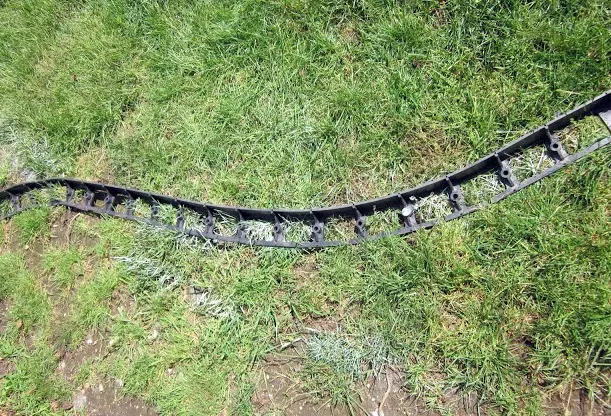
Step #3:
Decide what material you want to use for your stone fire pit. Some people use bricks. Some people like a little more decorative look so they use those Nicolock Pavers. You can pretty much use whatever you like, the key here is we are looking for something that will allow a protective barrier around the fire itself. Choose something that will not burn. You can even use rudimentary, river rock if you have some on your property you had laying around. It will be very caveman rustic looking, but if it is functional and holds the fire, you win!
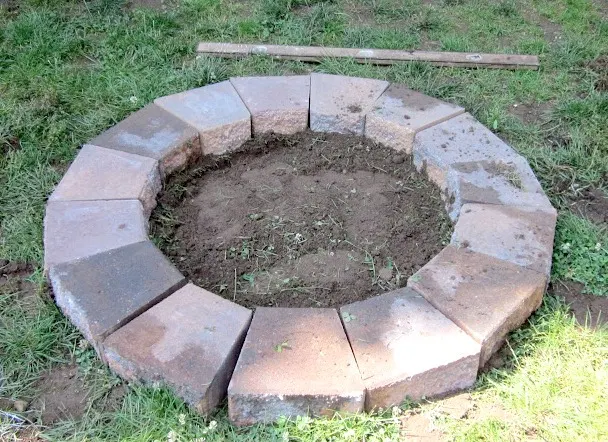
Step #4: Get Digging! Dig the grass around the area you marked off for the pit. Use a shovel and put some effort into it. This will not be easy, as grass has roots and you will have to really work at it. Work your way around the outline and remove all the grass from the middle. It doesn’t have to look pretty just yet, but will allow you to get access to the soil below with the shovel. Once you have the grass removed, now use the shovel to dig down into the soil two inches. You want two inches so your first layer of paver stones sit inside the edge you are digging and have a place to be anchored. Once you have a 2-inch depth all the way around and across the middle, you can use one of the pavers to tamp down and make the ground/dirt level across the entire circle (or rectangle) you dug out. It should start to look much nicer now. You are ready for pavers once you have this part done.
Step #5:
This part is all a matter of preference. You may want a very shallow fire pit (2-3 layers of brick/pavers). For myself, I like a fairly tall fire pit, so I will be using many pavers. I want mine 4-6 layers high, and I want a double ring, so I can sit down on it for nights where I want to be close to the warmth. Don’t forget to calculate how many pavers you will need for the bottom of the pit, if you choose to pave that as well.
Calculate the bricks/pavers: Approximately 15 pavers per layer. Mine will be 5 high. 75 pavers.
However, I want an extra ring to make the ledge of the pit wide for me to sit and warm my butt. So, I should calculate an additional 3 pavers per layer. 90 pavers.
Grand total of all pavers needed: 165 (That’s A LOT!)
Bottom: 16 pavers
Step #6:
Start laying down your brick or pavers! This is the fun part and usually goes very quickly.
If you are going to have brick for the bottom of your fire pit, do those first. Tamp them down a little bit so they are firmly into the dirt. For me, since I am more of the Preppy persuasion, I will skip placing pavers for the bottom of my fire pit and opt to have an Earthen bottom. (I like less work, not more)
On layer (ring) 3 as you are laying down the brick, make sure you leave an inch of space between two bricks, then do the same on the opposite side of that layer. That way you have built in breather holes. Then you can lay down the 4th layer per normal with the bricks touching all the way around.
You can choose to use construction caulk if you feel the need to have your bricks or pavers secured to each other. I don’t feel this is normally necessary, so I am choosing to also skip that part.
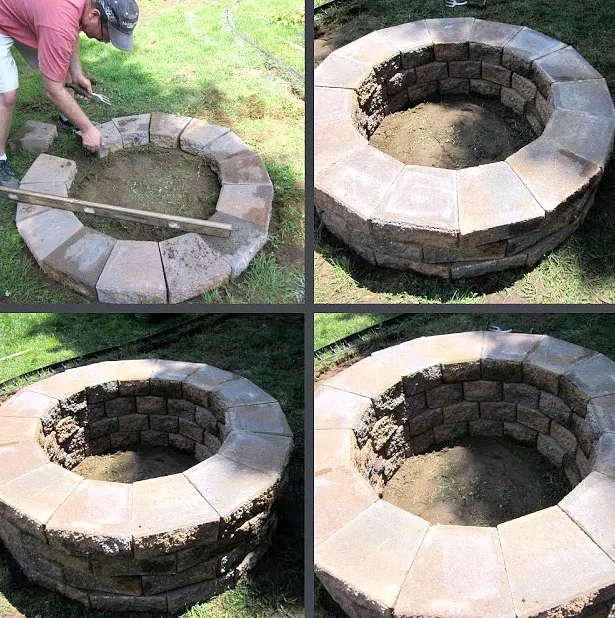
At this point, my fire pit is completed. I’ll grab some newspaper, some wood, and some whiskey! You can bring over the smores and grape soda! Let’s do this!!!
If you are continuing on to do the surrounding area around your firepit, I wish you the best! Please continue to step 7!
Step #7:
For your patio area around the fire pit, you can use some weed killer if you want to go over the grassy area within the boundary of your border rail (or spray painted) outline. If you opted to remove all the grass in this area, congratulations you are officially a harder laborer than I am. 😊 Now, get your black weed tarp/weed barrier, and start laying it down in the entire area that will be your patio. You can usually cut this easily with good scissors or a Utility knife. Once you have all the tarp/week barrier laid down, you can spike it in place with weed barrier spikes or some sort of landscape staples such as the ones here LAWNSTAPLES. They are super cheap and usually run about $12 for 100 of them.
Step #8:
Now you have to decide on what kind of fill to use for your patio area. There are numerous different choices out there, and it depends on what you are looking to achieve in terms of look. A lot of people use pea gravel because it is smaller and easy to traverse. I’ve even seen some people use pea gravel first, then place paver flagstones on top of that. (1.5 inch of pea gravel)
Some people use river rock because it is easy to have delivered. River Rock is okay, but it does make it a little more difficult to walk on. I’d say if you are looking to ease accessibility, then pea gravel may be the way to go.
Preppy Pro-Tip: try to place your patio in an area that will make it easy for the Pea gravel delivery man to back his truck up and pour the gravel out right in the area of your patio. It will make much less work using a wheel barrow to haul it from the front of the house, to the back. (lazy rules the day)
Start spreading out your pea gravel evenly. Try to get it as level and flat as possible, especially if you are planning flagstones on top of it. Nothing is worse than seeing wonky flagstones, at all manner of angles and looking all bad. Afterall, you don’t want your neighbors thinking you are an amateur at this do you?
Take some time leveling out the pea gravel. It will be worth it. Use a rake and get it moved into place. You can then use a 2x4 to lay on the ground and start using it as a scraper, to level things out even more. You can also place a carpenter’s level on the 2x4 at any place you feel isn’t quite level, and fix what is needed to
make it “Bubble Perfect”.

If you are doing flagstones, lay them out in some pattern that makes sense or makes you happy. If you plan to cover the entire area marked out, get to it and don’t drop them on your toes. That’s a lot of flagstones, but man will it look nice! Use a rubber mallet to hammer them down GENTLY so they nestle in the pea gravel nicely!
Final Step: Pull out the lawn chairs and enjoy your evening!
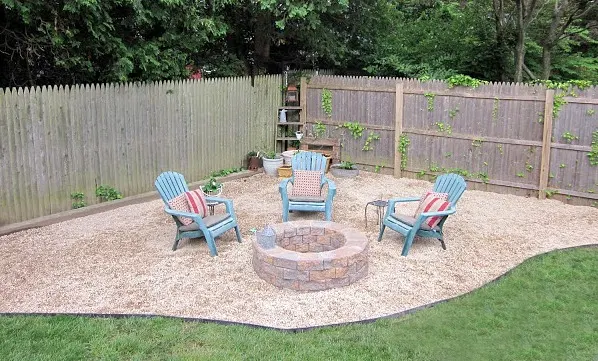
End Project Gr11/2024 Pictures sourced from: https://www.homeroad.net/2011/06/building-firepit.html
Family Cooking Day: Engaging Kids in Food Prep

Objective: Spend a day cooking with the family, preparing several meals that allow children to learn cooking basics under supervision.
Steps: Recipe Selection: Choose simple, fun recipes that children can participate in, like making personal pizzas, assembling tacos, or decorating salads. Safety First: Teach children kitchen safety, including how to handle utensils properly and the importance of cleanliness. Task Assignment: Give each child a job suitable for their age, such as mixing, measuring, or layering ingredients. Cooking Time: Work together to cook the meals. Use this time to discuss the importance of healthy eating and where food comes from. Enjoy Together: Finish by eating a meal everyone helped prepare, discussing what each person did and what they learned. Benefits: Introduces children to cooking Encourages family bonding Teaches valuable life skills
Essential Kitchen Tools for Efficient Food Prep

Equipping your kitchen with the right tools can make food preparation quicker, safer, and more enjoyable. Here’s a list of essential kitchen tools every home cook should consider:
Sharp Knives: A good chef’s knife and a paring knife are crucial for efficient chopping, slicing, and mincing. Cutting Boards: Have multiple boards to avoid cross-contamination between raw meats and other ingredients. Blenders and Food Processors: These are great for sauces, smoothies, and chopping or grinding bulk ingredients. Measuring Cups and Spoons: Essential for following recipes accurately. Slow Cooker or Pressure Cooker: These can drastically reduce cooking time and are excellent for making stews, soups, and tender meats. With these tools at your disposal, you can handle most recipes and techniques with ease, making your kitchen a more efficient and enjoyable place to cook.
The Art of Meal Planning: Strategies for Busy Lives
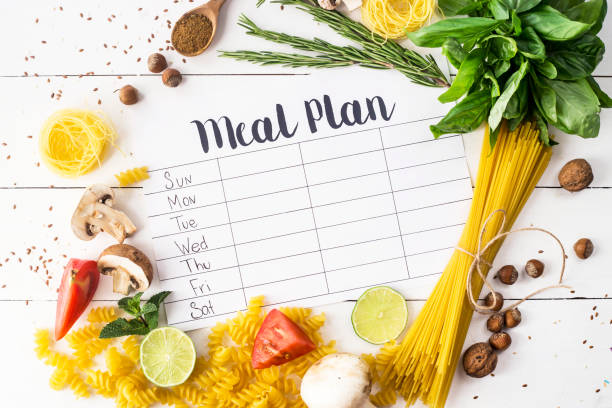
Meal planning can transform your daily routine, saving you time, reducing stress, and promoting healthier eating habits. To get started, begin by assessing your weekly schedule to determine how many meals you need to prepare. Here are some strategies:
Create a Meal Calendar: Use a digital calendar or a simple notebook to schedule your weekly meals. This helps avoid last-minute decisions and reduces food waste. Batch Cooking: Prepare large quantities of versatile ingredients like grains, proteins, and roasted vegetables at the start of the week. These can be mixed and matched to create different meals throughout the week. Themed Nights: Implement themed nights, such as “Meatless Monday” or “Taco Tuesday,” to simplify decision-making and add variety. Shopping Lists: Based on your meal plan, create a precise shopping list to streamline your grocery shopping and avoid impulse buys. With a little practice, meal planning can not only save time but also introduce new dishes to your repertoire, making mealtime a delightful experience.
Construction Techniques for Durable Bunkers
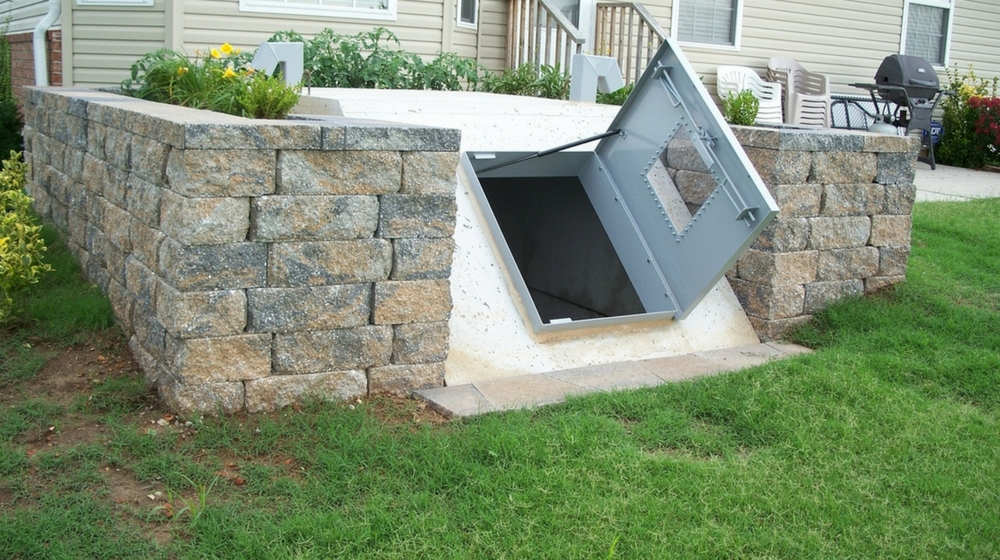
Underground Fortitude: Advanced Construction Techniques for Durable Bunkers
Summary: This article dives into the construction methods ideal for building a bunker that withstands time and elements. It explores the use of different materials, such as reinforced concrete and steel, and innovative technologies in waterproofing and structural integrity.
Key Sections: Choosing Construction Materials: Benefits and limitations of concrete, steel, and other composites. Building Methods: Traditional vs. modern construction techniques. Waterproofing and Insulation: Technologies to protect against moisture and temperature. Reinforcement Strategies: Earthquake-resistant features and structural reinforcements. Ventilation Systems: Ensuring air quality and circulation underground.
Planning and Designing Your Personal Bunker

Summary: This article serves as a guide to the preliminary planning stages required before building a bunker. It addresses location scouting, design considerations, and legal aspects to consider. The article also discusses different types of bunkers, from simple storm shelters to more elaborate underground living spaces.
Key Sections: Purpose and Type of Bunker: Choosing based on your needs—safety from storms, nuclear fallout, or other concerns. Location Considerations: Strategic placement, accessibility, and legal permits. Design Essentials: Size, ventilation, and long-term livability. Safety Standards and Legal Compliance: Understanding building codes and regulations. Cost Estimation and Budgeting: How to plan financially for your bunker project.
Integrating and Managing DIY Power Systems
Summary: This article focuses on the integration and management of multiple power sources into a cohesive home energy system. It discusses how to use smart controllers, energy management software, and battery systems to maximize efficiency and ensure a stable power supply, regardless of the variability of individual energy sources.
Key Sections: Integrating Multiple Energy Sources: Techniques and technologies. Smart Controllers and IoT: How technology can optimize usage. Energy Storage Solutions: Batteries and other methods to store surplus power. Monitoring and Adjusting: Tools to track and refine your system’s performance. Future Trends in Home Energy: Innovations to watch.
Hydroelectric Power at Home
Summary: This article explores the potential of mini hydroelectric generators for residential use. It covers how to assess the viability of a stream or river nearby, the types of hydro turbines available, regulatory hurdles, and the technical setup required to convert flowing water into electrical energy.
Key Sections: Assessing Water Flow: < a href = “product- afil code”> Tools </a> and methods to measure potential power. Selecting a Hydro Turbine: Types and their specific applications. Regulatory and Environmental Concerns: Permissions and impact assessments. Installation and Maintenance: Steps to ensure long-term success. Case Studies: Real-world examples of mini hydro setups.
Wind Energy at Home
Summary: For those with suitable environments, a home wind turbine can significantly offset energy costs. This article provides insights into selecting the right turbine, understanding wind patterns, installation, and integration with home energy systems. It also discusses the potential returns on investment and how to maximize efficiency.
Key Sections: Choosing a Wind Turbine: Size, type, and power output. Understanding Wind Patterns: How to assess your local wind resources. Installation Process: Erecting and securing your turbine. Integration with Home Systems: Connecting to the grid or a home system. Economic Considerations: Costs, savings, and incentives.
Solar Power Station DIY Guide
Summary: Solar energy is one of the most accessible and popular methods for DIY energy generation. This article delves into the specifics of setting up a solar power station, including choosing the right solar panels, understanding inverters, and battery storage options. It provides a step-by-step guide on installation and maintenance, alongside case studies of successful home solar projects.
Key Sections: Selecting Solar Panels: Efficiency, capacity, and cost considerations. Installation Steps: From mounting panels to connecting the grid. Battery Storage Solutions: How to store excess energy. Maintenance and Troubleshooting: Keeping your system efficient. Success Stories: Examples of effective home setups.
Introduction to Homemade Power Stations
Summary: This article serves as an introduction to the concept of homemade power stations. It explains the basic components needed, the types of energy sources you can harness (such as solar, wind, and hydroelectric), and the overall benefits and challenges associated with DIY power solutions. The piece also covers safety considerations, legal regulations, and initial steps to plan your project.
Key Sections: Understanding Your Energy Needs: How to calculate your energy requirements. Choosing a Power Source: Pros and cons of different renewable energies. Components Needed for Installation: Overview of inverters, batteries, controllers, etc. Safety and Legal Considerations: What you need to know before starting. Planning and Designing Your Project: Tips for a successful setup.
Emergency Preparedness and Response Planning
Step 1: Develop a Home Emergency Plan Create a comprehensive emergency plan for your household that includes procedures for various scenarios, such as burglaries, fires, natural disasters, and medical emergencies. Ensure all family members are familiar with the plan and know what to do in an emergency.
Step 2: Prepare an Emergency Kit Assemble an emergency kit containing essential supplies, including water, non-perishable food, first aid supplies, flashlights, batteries, and a battery-powered or hand-crank radio. Store the kit in a designated location that is easily accessible to all family members.
Step 3: Install Smoke and Carbon Monoxide Detectors Install smoke detectors on every level of your home and near sleeping areas, and test them regularly to ensure they are in working order. Additionally, install carbon monoxide detectors near sleeping areas and other areas where combustion appliances are present.
Step 4: Learn Basic First Aid and Self-Defense Take a first aid and CPR course to learn life-saving skills that could be invaluable in an emergency situation. Consider
Implementing Neighborhood Watch and Community Security Measures
Step 1: Form a Neighborhood Watch Group Gather interested neighbors to form a neighborhood watch group focused on improving security and communication within the community. Work together to establish a communication network and schedule regular meetings to discuss safety concerns and share information.
Step 2: Conduct Home Security Assessments Organize home security assessments for members of the neighborhood watch group to identify potential vulnerabilities and suggest improvements. Encourage participants to share tips and strategies for enhancing home security based on their experiences.
Step 3: Share Information and Resources Create a centralized communication platform, such as a social media group or email newsletter, to share relevant security information, crime updates, and resources with community members. Encourage neighbors to report suspicious activity to local law enforcement and each other.
Step 4: Coordinate Community Events Organize community events focused on crime prevention and home security, such as safety workshops, self-defense classes, and neighborhood cleanup days. Strengthening community ties can deter criminal activity and foster a sense of solidarity among residents.
Step 5: Advocate for Enhanced Security Measures Collaborate with local authorities and government agencies to advocate for enhanced security measures in the neighborhood, such as improved street lighting, increased police patrols, and the installation of surveillance cameras in public areas.
By implementing neighborhood watch and community security measures, you can work together with your neighbors to create a safer and more secure environment for everyone in the community.
Securing Your Home Network and Digital Devices
Step 1: Secure Your Wi-Fi Network Change the default username and password for your Wi-Fi router to a strong, unique combination. Enable WPA2 or WPA3 encryption to protect your network from unauthorized access. Consider hiding your Wi-Fi network’s SSID to make it less visible to potential hackers.
Step 2: Update Software Regularly Keep all devices connected to your home network, including computers, smartphones, and smart home devices, up to date with the latest security patches and firmware updates. Set devices to update automatically whenever possible to ensure they are protected against known vulnerabilities.
Step 3: Use Strong, Unique Passwords Create strong, complex passwords for your devices and online accounts, and avoid using the same password for multiple accounts. Consider using a password manager to generate and securely store passwords for easy access and management.
Step 4: Enable Two-Factor Authentication Add an extra layer of security to your online accounts by enabling two-factor authentication (2FA) wherever possible. This requires a second form of verification, such as a temporary code sent to your smartphone, in addition to your password, to access your accounts.
Step 5: Be Cautious with IoT Devices Carefully evaluate the security features of any internet-of-things (IoT) devices you bring into your home, such as smart thermostats, cameras, and voice assistants. Change default settings, disable unnecessary features, and regularly update firmware to minimize security risks.
By following these steps to secure your home network and digital devices, you can reduce the risk of cyber threats and protect your personal information and privacy.
Enhancing Indoor Security Measures
Step 1: Install a Home Security Camera System Set up surveillance cameras in key areas inside your home, such as the entryway, living room, and hallways. Choose cameras with motion detection and remote access capabilities so you can monitor your home from anywhere via your smartphone or computer.
Step 2: Secure Valuables in a Safe Invest in a fireproof and waterproof safe to store important documents, jewelry, cash, and other valuables. Place the safe in a discreet location, such as a closet floor or wall, and bolt it securely to the floor or wall for added protection.
Step 3: Use Smart Home Technology Consider integrating smart home devices like smart locks, doorbell cameras, and smart lighting into your home security system. These devices allow you to remotely control access to your home, receive alerts about suspicious activity, and even simulate occupancy when you’re away.
Step 4: Implement Access Control Measures Limit access to certain areas of your home by installing keyless entry systems or keypad locks on interior doors. This can help prevent unauthorized access to private or sensitive areas, such as home offices or storage rooms.
Step 5: Practice Good Habits Develop security-conscious habits like always locking doors and windows, even when you’re at home, and never leaving spare keys in obvious hiding spots outside. Encourage family members to memorize alarm codes and avoid sharing them with anyone outside the household.
By incorporating these indoor security measures into your home, you can create a safer and more secure environment for you and your family.
Strengthening Your Home’s Perimeter Security
Step 1: Install High-Quality Outdoor Lighting Illuminate the surroundings of your home with motion-activated lights. Place them strategically around entry points such as doors and windows. Bright lights act as a deterrent to potential intruders and also provide better visibility at night.
Step 2: Reinforce Doors and Windows Upgrade to solid-core or metal doors with sturdy deadbolts. Install strike plates with long screws to reinforce doorjambs. For windows, consider adding security film or grilles to prevent break-ins. Use window locks and ensure they are in good working condition.
Step 3: Invest in a Quality Alarm System Install a reliable alarm system that includes sensors on doors and windows, as well as motion detectors inside the house. Opt for a system that offers remote monitoring and alerts, so you can stay informed about any suspicious activity even when you’re away from home.
Step 4: Secure Outdoor Access Points Don’t overlook the security of garage doors, basement entrances, and other outdoor access points. Keep them locked when not in use and consider installing alarms or sensors to monitor these areas. Reinforce garage doors with additional locks or bolts.
Step 5: Maintain Landscaping Keep shrubs and trees trimmed to eliminate potential hiding spots for intruders. Avoid planting tall bushes near windows or entryways. Ensure there are no overgrown areas that could provide cover for someone trying to gain unauthorized access to your property.
By following these steps, you can significantly enhance the perimeter security of your home and reduce the risk of break-ins.
Emergency Communication Plan
Objective: Develop a family emergency communication plan.
Step 1: Identify Communication Needs
List all family members, their contact information, and any special communication needs (e.g., elderly relatives, children). Step 2: Choose an Emergency Contact
Designate a relative or friend outside your immediate area to be an emergency contact. Step 3: Document the Plan
Write out the plan, including local emergency numbers, meeting places, and the role of the emergency contact. Step 4: Distribute and Discuss the Plan
Ensure every family member has a copy of the plan and understands it. Step 5: Practice
Regularly practice what to do in an emergency, including evacuation routes and meeting places.
Basic Home Fortification
Objective: Enhance the security of your home.
Step 1: Secure Doors
Install solid core doors, deadbolts, and strike plate locks. Step 2: Strengthen Windows
Apply security film to windows or install window bars. Step 3: Lighting
Set up motion-detecting outdoor lighting around your home. Step 4: Alarm System
Install a basic home security system. Step 5: Community Awareness
Engage with neighbors and consider forming a neighborhood watch program.
Emergency Food Storage
Objective: Build a long-term food storage solution.
Step 1: Determine Storage Space
Identify a cool, dry place in your home that could serve as your food storage area. Step 2: Calculate Needs
Determine how much food you need per person for a desired period (e.g., 3 months). Step 3: Acquire Suitable Food Items
Purchase long-lasting staples such as rice, beans, canned goods, powdered milk, and grains. Step 4: Proper Storage
Use airtight containers and vacuum-sealed bags to store food. Label all containers with contents and expiration dates. Step 5: Rotate Supplies
Use and replace supplies regularly to keep the stock fresh.
Water Purification System
Objective: Set up a home water purification system.
Step 1: Choose a Purification Method
Research options such as UV purifiers, ceramic filters, and chemical treatments. Step 2: Assemble Materials
Purchase the chosen system or gather materials for a DIY filter (sand, charcoal, gravel, and a container). Step 3: Set Up the System
Follow manufacturer instructions for a purchased system or layer your DIY materials in a container for filtration. Step 4: Test the Water
Use water testing kits to ensure the water is safe to drink. Step 5: Educate Family Members
Teach everyone in the home how to use and maintain the system.
Building a Basic Emergency Kit
Objective: Create a 72-hour emergency kit for one person.
Step 1: Gather Supplies
Water: 1 gallon per person per day (3 gallons total) Food: Non-perishable, easy-to-prepare items (enough for 3 days) Flashlight with extra batteries First aid kit Multi-tool or Swiss Army knife Step 2: Pack Essential Documents
Personal identification Copies of important documents (insurance, home deed, birth certificates) Emergency contact list Step 3: Include Additional Essentials
Personal hygiene items (toothbrush, toothpaste, soap) Cash in small denominations Local maps Spare keys to your house and car Step 4: Store Your Kit in an Accessible Location
Keep the kit in a designated place known to all family members. If possible, have a similar kit in your car. Step 5: Maintain Your Kit
Check the kit every six months, replace expired items, and update your documents and supplies as necessary.
